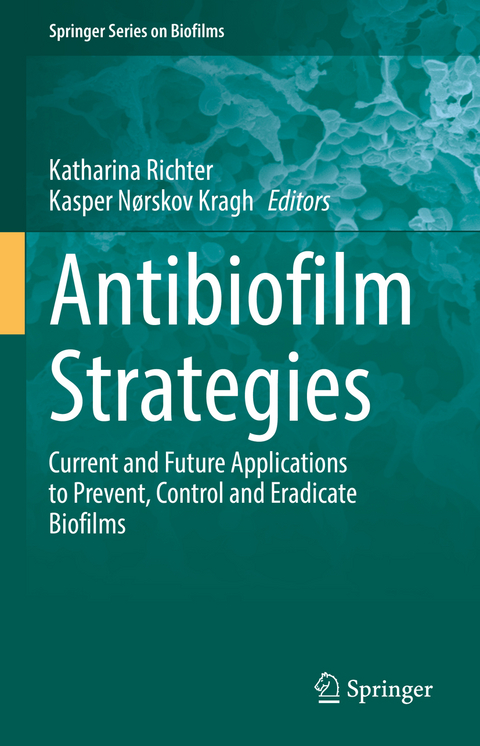
Antibiofilm Strategies
Springer International Publishing (Verlag)
978-3-031-10991-1 (ISBN)
Bacteria and fungi are able to aggregate together or on surfaces in densely packed microcolonies, facilitated by extracellular polymeric substances for cell protection and stability. These biofilms have proven to be extremely hard to eradicate and remove once established. In chronic infections, this condition can result in a high degree of morbidity and mortality as regular antibiotic treatments are ineffective against biofilms. In industrial facilities, the formation of biofilms can ruin production and result in enormous financial losses.
In this book, the current state of antibiofilm research is presented by experts from around the world. Novel, cutting-edge techniques and new optimized strategies based on established methods are discussed in chapters focused on biofilm prevention, treatment and control for the application in clinical, industrial and veterinary settings.Antibiofilm strategies, such as chemical and enzymatic treatments, surface modification and coatings, quorum sensing inhibition and dispersal induction, phage therapy, cold plasma treatment, hyperbaric oxygen treatment, and metal-based nanomedicine are covered, among many others.
This book contributes to the UN's Sustainable Development Goal 3: Good Health and Well-Being and is a valuable resource for healthcare professionals, microbiologists, academics and for educators to inform curricula of universities and colleges.
Dr Katharina Richter is an enthusiastic biomedical scientist, dedicated to improve therapies against antibiotic-resistant bacteria and biofilms. She has global work and research stints in Germany, Switzerland, Denmark, Belgium, The Netherlands, New Zealand and Australia. A trained pharmacist she completed her PhD in medicine & applied microbiology in 2017 and started her own research group in 2019 at the University of Adelaide, Australia. Her group has two priorities: i) developing new treatments against biofilm infections and bringing them from bench to bedside, and ii) improving health literacy of the society by effective science communication through public speaking, science outreach activities and STEM workshops at schools. Katharina collaborates with scientists, clinicians and industry partners to ensure a real life impact of her work. Dr Kasper Kragh obtained his Ph.D. in Health and Medical Sciences from the University of Copenhagen, Denmark. He has worked for over ten years at the Costerton Biofilm Center with a wide range of aspects concerning bacterial biofilm. During his scientific career, Kasper has focused his attention on the use of microscopy in biofilm research and how the phenotype of non-attached biofilm aggregates is involved and influences both pathogenesis and in vitro systems. The study of the mechanisms behind the chronic infectious state of biofilms, in in vivo-like in vitro models and direct infections, has been a red thread throughout his career.
Part 1: Introduction.- Chapter 1: Preface: Biofilms 101.- Chapter 2: Antimicrobial and innate immune tolerance mechanisms in biofilms.- Chapter 3: Antibiotic resistance development in bacterial biofilms.- Part 2: Biofilm Prevention & Treatment.- Chapter 4: Prevention of biofilms in catheter-associated urinary tract infections.- Chapter 5: Probiotics' action against biofilms.- Chapter 6: Clinical translation of biofilm dispersal agents.- Chapter 7: Chemical regulation of Pseudomonas aeruginosa biofilm formation as a potential treatment for persistent infections.- Chapter 8: Bacteriophages for the treatment of biofilm-associated infections.- Chapter 9: Hyperbaric oxygen treatment may advance the outcome of antibiotic treatment of biofilm infections.- Chapter 10: Cold plasma therapy as a physical antibiofilm approach.- Chapter 11: Antibodies against biofilms: Mechanisms and applications.- Chapter 12: Host defense peptides: Multifront attack on biofilms.- Chapter 13: Learning from nature: Naturally derived remedies.- Chapter 14: Historical medical remedies as potential anti-biofilm approaches: Can we look back to move forward?.- Part 3: Biofilm Control.- Chapter 15: The action of phytochemicals in the control of pathogenic biofilms.- Chapter 16: Current and future applications to control polymicrobial biofilms associated with oral disease.- Chapter 17: Clinical management of fungal biofilm infections.- Chapter 18: Metal-based nanoparticles for biofilm treatment and infection control: From basic research to clinical translation.- Chapter 19: Nitric oxide-mediated dispersal as an adjunctive strategy for the control of biofilm-associated infection.- Chapter 20: Biofouling control in water filtration systems.- Chapter 21: Biofilm in equine and other veterinary wounds.
"This book is a state-of-the-science exploration of how to prevent, treat, or control biofilms across a range of environments, including medical equipment, surfaces, and a diversity of animal hosts. The editors are to be commended on the background, basis, and breadth of this collection of chapters, as well as for recruiting excellent teams to pen them." (Fabrizio Spagnolo, The Quarterly Review of Biology, Vol. 98 (3), September, 2023)
“This book is a state-of-the-science exploration of how to prevent, treat, or control biofilms across a range of environments, including medical equipment, surfaces, and a diversity of animal hosts. The editors are to be commended on the background, basis, and breadth of this collection of chapters, as well as for recruiting excellent teams to pen them.” (Fabrizio Spagnolo, The Quarterly Review of Biology, Vol. 98 (3), September, 2023)
| Erscheinungsdatum | 01.10.2022 |
|---|---|
| Reihe/Serie | Springer Series on Biofilms |
| Zusatzinfo | XV, 573 p. 49 illus., 46 illus. in color. |
| Verlagsort | Cham |
| Sprache | englisch |
| Maße | 155 x 235 mm |
| Gewicht | 1045 g |
| Themenwelt | Medizin / Pharmazie ► Medizinische Fachgebiete ► Mikrobiologie / Infektologie / Reisemedizin |
| Naturwissenschaften ► Biologie ► Mikrobiologie / Immunologie | |
| Veterinärmedizin | |
| Schlagworte | Antibiotic tolerance • Antimicrobial Resistance • bacteriophages • Biofilms • Biofilm treatment • chronic infections • Health and Well-Being • Infectious Diseases • SDG 3 • therapeutics |
| ISBN-10 | 3-031-10991-0 / 3031109910 |
| ISBN-13 | 978-3-031-10991-1 / 9783031109911 |
| Zustand | Neuware |
| Haben Sie eine Frage zum Produkt? |
aus dem Bereich


